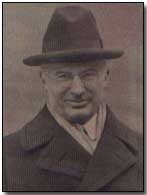Primary Documents - Daniel Willard on the Use of U.S. Railroads During Wartime, 1917
 Reproduced below is an
account of the co-operative role of the hundreds of private U.S. railroads
as part of the wider U.S. wartime effort. The report was written by
the President of the U.S. Railroads' War Board, Daniel Willard.
Reproduced below is an
account of the co-operative role of the hundreds of private U.S. railroads
as part of the wider U.S. wartime effort. The report was written by
the President of the U.S. Railroads' War Board, Daniel Willard.
In his report Willard noted that his task had been made so much easier by "the voluntary act of the 693 railroads... in merging their competitive activities for the period of the war". In summary he gave the industry a positive bill of health for its wartime services.
Daniel Willard, President of U.S. Railroads' War Board, on U.S. Wartime Railroad Transportation
The voluntary act of the 693 railroads of this country in merging their competitive activities for the period of the war and uniting in one continental system has not only, made the transportation problem presented by the war less cumbersome to handle, but surer of satisfactory solution.
In addition to welding into one loyal army each and every one of the 1,750,000 persons employed by the railroads, the coordination of the nation's carriers has made possible the most intensive use of every locomotive, every freight car, every mile of track, and every piece of railroad equipment in the country. It has also facilitated the securing of invaluable cooperation from the shippers and the general public.
Skilled and experienced railroad men have been sent to every cantonment to assist the constructing Quartermaster there in the movement of all supplies necessary to the erection and maintenance of these military cities.
A trained executive has also been stationed in the Washington Headquarters of the Supervising Constructing Quartermaster, so that every car needed in the transportation of Government supplies might be made available when needed.
As a result of these cooperative activities, the movement of thousands of carloads of lumber and other supplies has been accomplished practically without a hitch.
In addition, at the request of the Government, plans have been perfected whereby 1,000,000 men will be moved from nearly 5,000 different points to the thirty-two training camps for the National Army and National Guard by October 10th.
Among some of the things accomplished by the board in the first four months of its existence have been the organizing of special equipment for hospital and troop train service, the standardization of settlements between the Government and the railroads, eliminating a large volume of correspondence and red tape, and the creation of a special committee on express transportation, to coordinate the work of the companies with the general problem of transportation.
Car shortage has been reduced 70 per cent. On April 30th the so-called car shortage amounted to 148,627; on June 30th these figures had been cut to 77,144; on August 1st the excess of unfilled car requisitions over idle cars amounted to only 33,776.
In May freight transportation service rendered by about 75 per cent of Class 1 roads - earnings of $1,000,000 or more - was 16.1 per cent in excess of the service rendered in 1916. In that year, which was one of unusual activity, the freight service rendered by the carriers was 24 per cent in excess of that rendered in 1915.
Approximately 20,000,000 miles of train service a year has been saved by the elimination of all passenger trains not essential to the most pressing needs of the country. Freight congestion at many important points has been averted by promptly moving empty cars from one railroad to another, irrespective of ownership.
Through the pooling of lake coal and lake ore a saving of 52,000 cars in moving these commodities alone has been achieved. A further saving of 133,000 cars has been made possible by the pooling of tidewater coal.
By regulating the movement of grain for export, the number of cars ordinarily required for this service has been reduced, despite an abnormal export increase this year, 75,682,028 bushels of wheat, corn, barley, and oats being shipped to the Allies from May 1st to July 14th.
Commercial bodies and individual shippers in all parts of the country are giving hearty cooperation to the railroads' campaign to make one car do the work of two.
Source: Source Records of the Great War, Vol. V, ed. Charles F. Horne, National Alumni 1923
At the Battle of Sarikamish the Turks suffered a disastrously high 81% casualty rate.
- Did you know?
